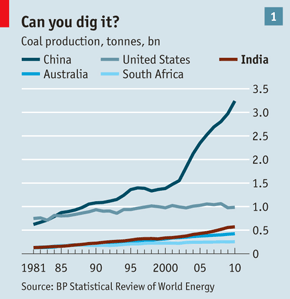India’s Energy Conundrum: Which way to go?
Despite all the talk for ages now, India’s energy situation has remained unresolved. For all the progress that India is slated to do in the coming years, the lack of proper infrastructure, of which energy is the most crucial component – will be a key villain. Unless the resources are used properly and private players are better utilized, there can be little increase in productivity. SEBs have basically run India’s energy situation into the ground! And they are steeped in pilferage and corruption.
Economist article argues for a future based on the abundant coal reserves used well – with the help of better technologies.
There is also a risk that India cannot deliver the long-term increase in electricity generation that its economy needs to fulfil its potential. On January 18th a group of influential businessmen gathered in Delhi to bend the prime minister’s ear on this very matter.
The problem is partly one of design. Coal is dug up by a state-monopolist that has failed to boost output significantly in recent years, unlike China (see chart 1), and so cannot keep up with demand. Power is distributed to homes and firms by publicly owned grid companies that are often bankrupt, their tariffs kept too low by local politicians. Trapped in the middle are the firms that run power stations. In desperation they are importing pricier foreign coal, but the grid companies cannot afford the power it produces. With too little coal and wobbly customers, the private firms that have built new power stations are in financial trouble. Another wave of private investment looks unlikely.
In India, though, no one expects perfect design. The economy sits somewhere between the old command-and-control approach and the new ways of markets and private capital. What is worrying is that India’s talent for improvisation—a collective ability to muddle through—has deserted it when it comes to providing electricity.




